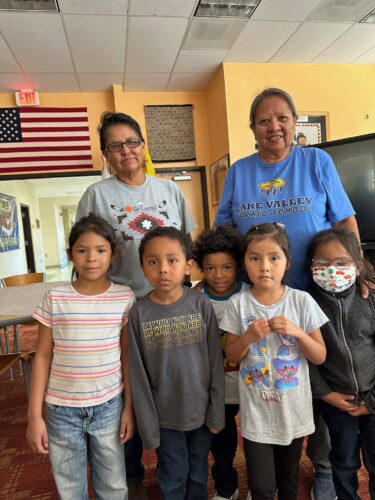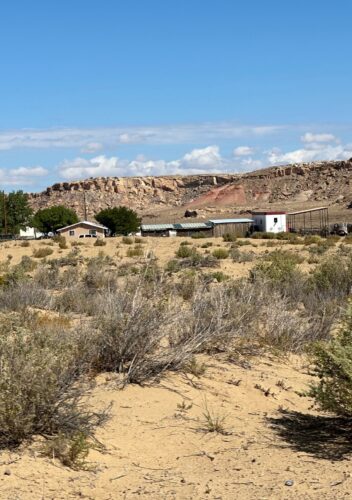Today we hear from our Director of U.S. Programs, Renée Kube, about her trip to New Mexico last fall, where she and our Assistant Director of U.S. Programs, Kristen Walthall, visited eight affiliated sites.
Understanding the Navajo Nation
“The Navajo are the largest Native American tribe in the United States. The Navajo Nation also has the largest land mass of any tribe. The nation is located in the greater ‘Four Corners’ region of the United States, where Arizona, New Mexico, Colorado, and Utah meet in a quadripoint, the only place in the U.S. where this occurs,” said Renée.
“The entire school has worked hard to showcase to the community the advantages of a smaller school where the children get more personal attention.”
“Children Incorporated’s affiliations within the Navajo Nation are located in Arizona and New Mexico. The lands within the northeastern part of Arizona area belong wholly to the Navajo Nation, with the exception of a part carved out for the Hopi Nation. However, the lands within northwestern New Mexico belong to a variety of jurisdictions: federal, state, tribal, private, and allotment. This is why the Navajo region in New Mexico is popularly called ‘The Checkerboard.’ As Kris and I were driving in this part of New Mexico, we were going in and out of various parts of the checkerboard.”
“In recent years, the Navajo Nation has been working hard to (among other things) formally enroll its residents as Navajo citizens. There are requirements to formal enrollment in a tribe, with the intention of preserving the unique character and traditions of each tribe. The tribes establish their own membership criteria based on shared customs, language, traditions, and tribal blood. These criteria for membership are set forth in the tribes’ constitutions, articles of incorporation, and/or ordinances. Uniform membership requirements do not exist; it varies from tribe to tribe,” explained Renée.

Veronica and Jeanette are pictured with some of our sponsored children at Lake Valley.
“The enrollment numbers matter, not only for emotional reasons such as tribal identity and history, but for practical reasons as well— tribes are often allocated money based on their number of enrolled citizens. Before the pandemic, the Navajo enrollment was around 306,000 people. During the pandemic membership drive, the Navajo Nation was able to have many residents formally establish their eligibility and then enroll. By 2021, the Navajo’s tribal rolls had grown to almost 400,000 people. With this achievement, the Navajo Nation surpassed the Cherokee Nation (whose enrollment is 392,000 people). A recent example of the importance of enrollment numbers is the money awarded to tribes, based on their enrollment numbers, from the federal CARES (Coronavirus Aid, Relief, and Economic Security) Act and the American Rescue Plan Act.”
“Every amount of assistance helps, because according to a special article in 2019 by the New Mexico Department of Workforce Solutions, the state had the third-highest rate of child poverty in the U.S. (24.9%). This means nearly one in four New Mexico children lived in poverty in 2019. Only Mississippi and Louisiana were higher. When analyzing the data by ethnicity, the rate for Native Americans was higher than for all other groups. During the pandemic, things actually got a bit better for families, due to federal relief payments. Now that the pandemic relief has ended, the situation is worsening again. The Annie E. Casey Foundation’s 2023 Kids Count databook shows that New Mexico’s children rank last in the nation for well-being. The poverty rate is high, and New Mexico also ranked last in education and 45th in health,” said Renée.
About Lake Valley Boarding School
“The remote town of Crownpoint is located in northwestern New Mexico, near the Arizona border and the vast Navajo Indian Reservation. Despite the wealth of natural beauty in this area, the Navajo Indians who live in this region are desperately poor. There is virtually no employment. Broken homes, alcoholism, and inadequate food are constant manifestations of poverty.”
“Both expressed their deep appreciation for the Hope In Action grants that Lake Valley Boarding School received during the height of the pandemic.”
“Though one of the smaller schools in the Bureau of Indian Affairs system, the Lake Valley Boarding School provides a safe haven where Navajo students, whose homes are far away, are able to live and learn in a healthy, supportive environment. Most parents struggle to afford clothing, school supplies, and basic necessities for their children. Were it not for the Lake Valley Boarding School, so many children would have little opportunity to dream or to rise above the difficult socioeconomic circumstances from which they come,” explained Renée.
Renee’s Visit
“With a name like ‘Lake Valley,’ one would expect water and green grass, but that is not the case. The lake dried up years ago and is largely a sand trap now. The elders remember when the lake was full, there were farm fields, and two active trading posts. In the olden days, Lake Valley was a stagecoach stop between Crownpoint and Farmington, and the lake and a spring offered cool water to travelers and their horses.”
“The community is only seven miles from the famous Chaco Culture National Historic Park. Residents dream of drawing in tourists with an RV park and a little restaurant. But for now, improvements are still only a dream. In reality, due to budget cuts, services to this area are very limited. Community health representatives have had to reduce their visits to homebound elders. Young families had been leaving, and it got worse during the pandemic,” said Renée.

Lake Valley Boarding School is located in a remote area of New Mexico with few options for shopping.
“After going down a dirt and gravel driveway, I reached a small cluster of buildings with pretty trees planted to provide some shade for everyone. I walked to the main entrance at Lake Valley Boarding School — Home of the Mighty Lakers. I was warmly greeted by our two co-coordinators, Jeanette and Veronica, and taken to the library for a meeting. They explained to me that they drive almost 60 miles north to shop in Farmington. They like to go either to Walmart or to JCPenney, which has really good sales. They meet the parents there, and pay for the items after the parents and children have made their selections. Sometimes they drive about 35 miles south to Crownpoint, which has a Bashas’ grocery store where they will occasionally purchase food for families in need. Both Jeanette and Veronica are very conscientious about getting the best value for every donor dollar.”
Adjusting since the pandemic
“Both Veronica and Jeanette shared that during the pandemic, they lost even more of their students. In some cases, families moved from the area. But in other cases, the parents felt their children would have more services at the bigger schools in Farmington. The Farmington Municipal Schools buses will actually drive halfway to Lake Valley to pick up and drop off the children,” said Renée.
“The entire school has worked hard to showcase to the community the advantages of a smaller school where the children get more personal attention. In fact, Jeanette and Veronica shared that one of the students had withdrawn at the end of last school year. The girl started the new school year in August at Farmington, but she was not happy, and so her parents re-enrolled her this week at Lake Valley. Her classmates had missed her, and they were thrilled to welcome her back.”
“Both Jeanette and Veronica were initially hired to work in the dorm. However, during the pandemic the dorm was shut down when the school moved to fully remote instruction. Because some staff left during the pandemic, this created openings so that Jeanette and Veronica didn’t lose their jobs. They were instead transferred to other duties. This year the dorm has reopened, but there are only five children living there during the school week. Jeanette and Veronica take turns staying there overnight, but they do other things for the school to keep up their full-time hours. Both are hoping more children will be enrolled in the dorm over time, as things continue a slow return to normal there,” explained Renée.
“As the dorm starts to add more residential students, Jeanette and Veronica said they will be applying for Hope In Action funding for new bedding sets as well as hygiene items and supplies.”
“When the pandemic started and the dorm shut down, Jeanette and Veronica gave away much of the bedding to the children as they were checked out. They realized that, due to policies on infection, the bedding could not be reused. As the dorm starts to add more residential students, Jeanette and Veronica said they will be applying for Hope In Action funding for new bedding sets as well as hygiene items and supplies. Both expressed their deep appreciation for the Hope In Action Fund grants that Lake Valley Boarding School received during the height of the pandemic. While the school and dorm were closed and the children were doing remote learning in their homes, our organization helped with cellular service and hotspot boxes,” said Renée.
“This is the second school year that school is supposedly back to normal with fully in-person instruction. But many of the families have not returned. There are only 22 students enrolled at Lake Valley Boarding School – and everyone is enrolled in our program and is sponsored. Jeanette and Veronica are doing a beautiful job. They are eager to enroll more children, as more families move to the community.”
***
How do I sponsor a child with Children Incorporated?
You can sponsor a child in one of three ways: call our office at 1-800-538-5381 and speak with one of our staff members; email us at sponsorship@children-inc.org; or go online to our sponsorship portal, create an account, and search for a child that is available for sponsorship.

